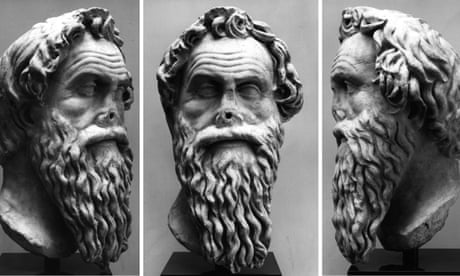
Sotheby’s has been approached for comment. Asked about the marble head, Christie’s said it had “a rigorous process for assessing cultural property that follows international and national agreements, laws and regulations”.
Tsirogiannis is an associate professor at the Aarhus Institute of Advanced Studies and head of the working group Illicit Antiquities Trafficking of the Unesco chair on threats to cultural heritage and cultural heritage-related activities, Ionian University, Greece. The photographs were among archival material seized by police and held by authorities in Greece and Italy.
In the text, he wrote that the head of Antisthenes first surfaced at Sotheby’s New York in 1981, with its nose worn away. He said it was offered “without any information regarding its consigner or collecting history” and sold for ,840. In 2013, after he approached Sotheby’s for details, he received an email stating: “Sotheby’s does not disclose the names of consigners or buyers.”
The marble head, larger than life at 45.7cm tall, dates from the late 1st to early 2nd century AD and has been predicted to fetch a price of between 0,000 and 0,000 (£80,000-£120,000).
He said there was no record of this antiquity before the Sotheby’s 1981 sale, and that it could have come “from any country that was part of the Roman empire, given the quality and knowing how much Italy has been looted”.
An archaeologist is calling for a US auction house to withdraw a monumental Roman sculpture from sale, claiming he has photographic evidence of its direct link to a dealer involved with illicit trade.
Tsirogiannis has repeatedly argued that auction houses do not make adequate checks with Greek and Italian authorities, and criticised their failures to disclose an object’s full collecting history.
Tsirogiannis has three photographs that he said show the same piece in the possession of the disgraced British antiquities dealer Robin Symes and his late partner Christos Michaelides. The only difference was that the entire nose was missing and had since apparently been repaired, he said.
He is all the more critical of the Hindman sale because he published details of this object and its “true collector history” in the Journal of Art Crime in 2013. He argued that if the US house had simply searched online about the sculpture, it would have found his paper “freely available”.
Sign up to First Edition, our free daily newsletter – every weekday at 7am BST
In 2005 Symes served a jail sentence for disregarding court orders over the sale of a £3m Egyptian statue, with the judge dismissing his explanation as “a calculated deception”. In 2016 Italian and Swiss police recovered marble statues and other treasures stolen from Italy, which they said had been stored by Symes at the Geneva freeport in Switzerland. Symes has never faced any action from the authorities in relation to the haul and has remained out of the public eye.
Asked about the sale and Tsirogiannis’s allegations, Hindman Auctions said: “As is standard procedure for each of our sales, we cleared this lot with both the Art Loss Register and Interpol prior to bringing it to auction … Should credible information emerge, then we would, of course, re-evaluate the piece and work to restore it to its rightful owners.”
Prof Christos Tsirogiannis, whose academic research focuses on antiquities and trafficking networks, said Hindman Auctions in Chicago should cancel its auction of the portrait head of Antisthenes, the Greek philosopher, scheduled for Thursday.
He said the sculpture had reappeared at Christie’s New York in 2012, as part of an anonymous private collection. “In the auction catalogue, the nose appears fully restored, but Christie’s failed to mention this restoration in [its] description. They also failed to mention its auction in Sotheby’s 1981 … The head was estimated at 0,000-0,000, but apparently remained unsold.” It is believed to have been sold by Christie’s as an after-sale.
Through his research, he received official access to tens of thousands of images and other archival material seized in police raids from individuals involved in the illicit trade. Over 15 years he has identified almost 1,600 looted antiquities within auction houses, museums, galleries and private collections, and notified authorities. He has played a major role in securing the repatriation of many antiquities to their countries of origin.
It added that the presence of photos of the work in the home of Symes and Michaelides “is not in itself proof that it was either owned or traded by” Symes.
The recoveries include an ancient Greek bronze horse that Sotheby’s New York had planned to sell in 2018, until he notified the authorities of its links to Symes. Greece claimed the horse as its national property, and in 2020 Sotheby’s lost its legal challenge. Greece’s culture minister welcomed the court’s ruling as a victory for countries seeking to reclaim their antiquities.
Tsirogiannis said that while the Hindman provenance or ownership history includes the Sotheby’s and Christie’s auctions, it “excludes Symes-Michaelides – something that Christie’s also failed to do back in 2012”.

